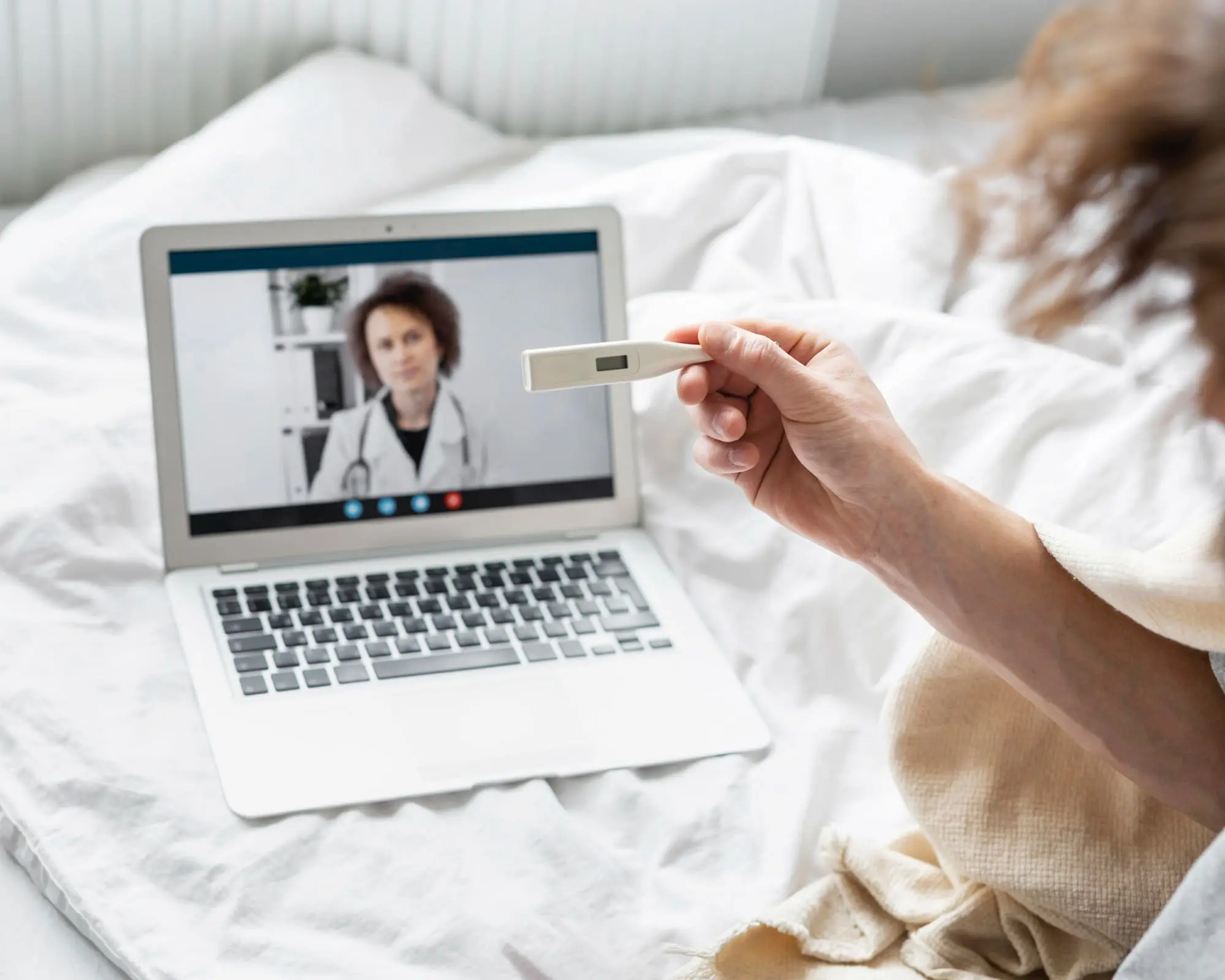Table of Contents
Listen to article
The global telemedicine market is projected to reach $163 billion by 2029, driven by rising demand for remote healthcare access and advancements in digital health technologies (Statista, 2024). This growth is mainly driven by increasing demand for remote healthcare access and continuous advancements in digital health technologies.
For healthcare providers, telemedicine app development solutions offer a way to extend care beyond traditional settings, while patients benefit from improved access, cost savings, and better health outcomes.
This comprehensive guide explores how healthcare organizations can build secure, user-friendly telemedicine platforms, with detailed insights into essential features, development costs, technology requirements, and implementation strategies.
What are Telemedicine App Development Solutions?
Telemedicine app development solutions are software platforms that enable remote healthcare delivery. Leading telehealth app development companies create these solutions by integrating four core components:
- Video Calls: High-quality, face-to-face virtual appointments that enable healthcare professionals to provide immediate medical guidance, have proven to be as or more effective than in-person care for certain conditions, including mental health management.
- Secure Messaging: Protected communication channels that comply with HIPAA regulations, ensuring private exchanges between patients and their healthcare providers.
- Appointment Scheduling: Automated appointment management systems that streamline the booking process, send timely reminders, and reduce missed appointments through intelligent calendar integration.
- EHR Integration: Seamless EHR connectivity that gives healthcare providers instant access to complete patient histories, enabling more informed and targeted care decisions.
Through these integrated features, telemedicine app development services create a seamless healthcare experience that boosts patient involvement and leads to better health outcomes.
Types of Telemedicine Apps & Their Use Cases
Telemedicine app development solutions come in different forms, each designed for specific healthcare needs. Knowing these types helps healthcare providers select the right solution for their practice.
On-Demand Virtual Consultations
When patients need immediate medical attention that doesn’t require physical examination, on-demand virtual consultations provide the solution. These telemedicine app development solutions enable instant video connections between patients and doctors. Parents can get quick medical advice for their sick children, or individuals with sudden flu symptoms can consult doctors without leaving home.
Remote Patient Monitoring (RPM)
RPM solutions improve chronic condition management. Through wearable devices and smart sensors, these telemedicine app development services continuously track vital health metrics. For instance, cardiac patients’ heart rates and blood pressure readings are monitored in real-time, allowing doctors to spot concerning trends before they become emergencies. Diabetic patients can share glucose readings automatically, enabling timely treatment adjustments.
Store-and-Forward Telemedicine
This approach to telemedicine handles cases where immediate interaction isn’t essential. Healthcare providers can review patient data, images, or test results at convenient times. For example, dermatologists can examine photos of skin conditions, or radiologists can review X-rays and provide detailed feedback, all without requiring real-time patient interaction.
Teletherapy & Mental Health Apps
These telemedicine apps break down barriers to mental healthcare access. Patients connect with mental health professionals from the privacy of their homes, making regular therapy sessions more convenient and accessible. This model serves talk therapy, counseling sessions, and regular mental health check-ins effectively.
Specialty-Focused Solutions
Different medical specialties have unique needs, and specialty-focused telemedicine app development solutions address these specific requirements. A dermatology platform might emphasize high-quality image sharing, while a cardiology solution could focus on integrating with heart monitoring devices.

Choosing the Right Telemedicine Model
The effectiveness of telemedicine services depends on implementing the right model for specific situations. Here’s how each model matches different healthcare needs:
On-demand virtual consultations are optimal for organizations that:
- Provide immediate care for urgent but non-emergency conditions
- Offer after-hours medical support
- Aim to reduce unnecessary emergency room visits
- Handle quick medical advice or prescription refills
Remote Patient Monitoring serves healthcare providers who:
- Track chronic conditions over time
- Work to prevent hospital readmissions
- Adjust treatment plans based on real-time data
- Support patient health management at home
Store-and-Forward solutions benefit practices that:
- Regularly review medical images or test results
- Collaborate with other specialists
- Require flexibility in response timing
- Handle conditions that don’t require immediate feedback
Specialty practices often require custom telemedicine app development solutions tailored to their specific field – whether it’s cardiology, dermatology, or mental health therapy.
When choosing among these telemedicine software development solutions, consider your specific needs: who your patients are, what type of care you provide, and what your future expansion plans are.
Many healthcare organizations find success by starting with a core model that addresses their primary needs, then expanding their telemedicine services as their virtual practice evolves.
Key Features of Telemedicine App Development Solutions
Effective telemedicine app development solutions require practical features that make healthcare accessible and efficient for everyone involved in the healthcare process. While all these features benefit the entire healthcare ecosystem, they’re grouped below based on their primary users to better understand how each feature addresses specific needs in everyday healthcare:
For Patients
High-Quality Video Appointments
When in-person visits aren’t possible, high-quality video consultations connect patients with healthcare providers instantly. This is especially valuable for patients in rural areas, who benefit from increased access to care and decreased healthcare costs.
Virtual Diagnosis and Pre-screening
Any robust telemedicine app development solution must include smart pre-screening systems that help patients determine their needed level of care. The system acts as a health assistant: patients describe their symptoms, and the system determines whether they need urgent care, a video consultation, or emergency services. For instance, when someone reports chest pain and shortness of breath, the system immediately flags this as urgent and facilitates an emergency service connection.
Online Appointment Booking with Smart Reminders
The appointment booking process mirrors the simplicity of modern online reservations.
Studies indicate that telemedicine appointments have significantly lower no-show rates compared to traditional appointments.
Through this feature, patients select their preferred time slots, and the system automatically sends reminders via text or email. When conflicts arise, rescheduling takes just a few clicks, with the system suggesting alternative times based on both patient history and doctor availability.
Secure Messaging and Real-time Chat
Healthcare providers become easily accessible through secure messaging. Patients can share photos of healing wounds, inquire about medication side effects, or seek clarification about treatment instructions – all through encrypted communications that protect sensitive medical information.
Wellness Tracking (RPM)
The system monitors health metrics like a sophisticated health diary. Studies show impressive results: patients using remote monitoring devices experienced a 50% reduction in hospitalizations.
RPMs can track vital signs, log symptoms, or monitor recovery progress. The application sends timely reminders for measurements and alerts healthcare teams about concerning changes.
Comprehensive Patient Portal
This digital health hub centralizes all medical information. Patients access their complete medical history, test results, and upcoming appointments in one secure location. The portal delivers lab results immediately upon availability and streamlines prescription refill requests.
Online Billing and Insurance
Financial management becomes paperless and efficient. Patients can verify insurance coverage before appointments, process payments securely, and monitor healthcare expenses comprehensively. The system provides cost estimates upfront, helping patients understand their financial responsibilities.
For Healthcare Providers
Electronic Health Records (EHR) Integration
Advanced telemedicine app development services ensure healthcare providers gain instant access to comprehensive patient information during consultations. A well-integrated telehealth app with EHR systems directly contributes to: improved health results, enhanced patient satisfaction, decreased medical costs, and improved clinician experience.
The system displays allergies, treatment history, and recent lab results in an organized format, with automatic highlighting of critical information such as drug allergies.
E-Prescribing System
Digital prescription management includes built-in safety protocols. The system sends prescriptions directly to patients’ preferred pharmacies, provides alerts about potential drug interactions, and manages refill requests efficiently. Built-in checks help prevent medication errors and streamline the prescription process.
Remote Patient Monitoring
Healthcare providers can track patient health between appointments through connected devices. The system monitors crucial health metrics, such as blood pressure readings for cardiac patients or glucose levels for diabetic patients, enabling early intervention when concerning trends emerge.
Practice Management Dashboard
The virtual practice management system mirrors the efficiency of a well-organized physical office. Healthcare providers can oversee appointment schedules, manage virtual waiting rooms, and coordinate with team members through a centralized dashboard. The system automatically prioritizes urgent cases and manages follow-up protocols.
Administrative and Technical Features
Secure Document Management
The platform safeguards patient information with enterprise-grade security measures. Every interaction, from messages to video calls and health records, receives end-to-end encryption protection, ensuring compliance with healthcare privacy requirements.
Cloud-Based Electronic Health Records (EHR)
Secure cloud storage enables authorized access to health records from any location. The system maintains automatic backups and scales seamlessly with practice growth, eliminating storage capacity concerns while ensuring data availability.
Detailed Reporting and Analytics
The analytics system makes decision-making simpler with easy-to-understand reports. Administrators can track busy hours, popular services, and patient satisfaction scores with just a few clicks.
For example, when the system shows high appointment bookings on weekends, clinics can adjust their scheduling to meet this patient demand. The reporting tools reveal clear patterns about when patients prefer appointments, which services they use most, and where the practice can improve – all presented in clear, actionable insights.
Insurance and Payment Processing
The financial management system operates continuously to streamline healthcare payments. It performs instant insurance verification, secure payment processing, and automated claims tracking. This automation ensures efficient revenue cycles while simplifying patient payments.
Each feature in a custom telemedicine app development solution works in concert to deliver healthcare that’s accessible, efficient, and secure. The system transforms complex medical processes into straightforward interactions for patients, healthcare providers, and administrators alike.
For a complete overview of how these features of telemedicine app development solutions benefit different user groups, explore the detailed breakdown in the table below:
| Patients | Healthcare Providers | Admins & Business Owners |
| Live video consultations (Twilio, Agora, WebRTC) | EHR & patient record integration (FHIR/HL7 compliance) | Regulatory compliance & data security (HIPAA/GDPR) |
| Online appointment scheduling & reminders | Appointment & workflow management tools | Billing & payment processing (Stripe, PayPal, insurance integration) |
| HIPAA-compliant secure messaging | AI-powered diagnostics & decision support tools | Analytics & reporting dashboards |
| EHR & medical records access | Prescription management & pharmacy integration | Role-based access controls |
| AI-driven symptom checker (emerging trend) | Patient data analytics & reporting | Audit logs & compliance tracking |
Step-by-Step Process: How to Develop a Telemedicine App?
With these required features identified, the development process can begin by following these key steps:
Market Research & Competitor Analysis
Begin by identifying your target audience (e.g., rural patients, chronic disease sufferers) and analyzing competitors. Use tools like SimilarWeb or App Annie to study rival apps’ strengths and weaknesses.
For example, if most competitors lack multilingual support, prioritize it to stand out. Simultaneously, define compliance requirements early—such as HIPAA for U.S. apps or GDPR for EU markets—to avoid costly revisions later.
Survey healthcare providers and patients to uncover unmet needs. For instance, therapists may demand asynchronous messaging, while elderly patients might prefer voice-based navigation.
Define Features & User Flow
Prioritize a Minimum Viable Product (MVP) with core features:
- Patients: Video consultations, appointment scheduling, secure messaging.
- Providers: EHR integration, prescription management, dashboards.
Phase in advanced features like AI diagnostics or IoT device integration post-launch. Map user flows to ensure seamless navigation. For example, a patient’s journey from symptom input to booking should take fewer than five clicks.
Choose the Right Technology Stack
Select frameworks and tools that balance scalability, security, and cost:
- Frontend: React Native or Flutter for cross-platform apps
- Backend: Node.js (scalability) or Python (AI/ML capabilities).
- Databases: PostgreSQL for structured EHR data; Firebase for real-time updates.
- APIs: Twilio (video calls), FHIR (EHR integration), Stripe (payments).
Opt for HIPAA-ready APIs to simplify compliance.
UI/UX Design & Wireframing
Design intuitive interfaces tailored to your users:
- Patients: Large buttons, voice commands, and high-contrast fonts for accessibility.
- Providers: Dashboard widgets for quick access to patient histories and lab results.
Use Figma or Adobe XD for wireframing and conduct usability tests with 5–10 stakeholders to refine layouts.
Backend & Frontend Development
Adopt agile methodologies to build incrementally. Start with patient-facing features, then develop provider dashboards. Use automated testing tools like Selenium to catch bugs early.
You can also assign a dedicated QA team to test on low-end devices and slow networks, ensuring broad accessibility.
Integrate APIs & Third-Party Services
Connect critical services:
- Video Calls: Twilio or Zoom SDKs for stable, low-latency streaming.
- EHR Systems: Redox or SMART on FHIR APIs for seamless data exchange.
- Payments: Stripe with insurance API integrations for automated claim processing.
Use sandbox environments to test API integrations without affecting live data.

Security Testing & HIPAA Compliance Checks
Conduct rigorous security audits:
- Penetration Testing: Simulate cyberattacks to identify vulnerabilities.
- Encryption: AES-256 for data at rest; TLS 1.3 for data in transit.
- Compliance: Validate HIPAA requirements like audit logs and access controls.
You can also hire third-party auditors for unbiased compliance certification.

Deployment & Post-Launch Maintenance
Deploy on scalable cloud platforms like AWS or Azure. Post-launch:
- Monitor performance with tools like New Relic.
- Roll out updates biweekly to fix bugs and add features.
- Collect user feedback via in-app surveys to guide improvements.
Allocate 15–20% of your budget for post-launch support—server costs, security patches, and feature updates.
From market research to deployment, every step is critical. By leveraging proven frameworks and APIs—and guided by expert healthcare software development practices—you can build a scalable, compliant solution that meets today’s healthcare demands.
Cost Breakdown of Telemedicine App Development
The cost of building a telehealth app depends on the functionality you want. Here’s a breakdown:
Basic MVP Telemedicine App: $30,000 – $55,000 (2-3 months)
- Includes: Secure video calls, appointment scheduling, basic chat, user authentication.
Fully Functional Telemedicine Platform: $80,000 – $200,000+ (6-12 months)
- Includes: AI analytics, EHR integration, remote patient monitoring, multi-user roles, high scalability.
Key Factors Influencing Costs of Telemedicine App
The cost of custom telemedicine app development solution depends on several key factors, including features, platform choice, design complexity, and security requirements. Below is a table outlining the main cost drivers:
| Factor | Cost Estimate | Details |
| Features & Functionalities | Basic: $10-$20k Advanced: $30-$50k+ | More features increase costs, e.g., video calls, AI diagnostics, remote monitoring. |
| Platform Choice | Single platform: Lower Cross-platform: Higher but saves in the long run | Developing for both iOS and Android increases costs compared to a single-platform app. |
| UI/UX Design Complexity | Basic: $5-$15k Advanced: $15-$30k | Simple designs cost less; custom, high-end designs increase expenses. |
| Integrations with Other Systems | Basic: $10-$25k Complex: $25-$50k+ | Connecting with EHRs, payment systems, or analytics tools affects pricing. |
| Development Team Location | JS: $100-$150/hour Eastern Europe/Asia: $40-$80/hour | Developer rates vary significantly by region. |
| Maintenance & Support | 15-20% of initial cost per year | Includes updates, bug fixes, and compliance updates. |
| Security & Compliance | $20-$50k+ | HIPAA/GDPR compliance, data encryption, and secure authentication add costs. |
Need help? Partner with a trusted telemedicine software development company like Scopic to select the right stack and stay within budget.
Technology Stack for Telemedicine App Development
Leading telehealth app development companies rely on a mix of frameworks, APIs, and infrastructure to deliver secure, scalable, and user-friendly platforms. Below is a breakdown of the core technologies required to build a compliant telemedicine app:
Frontend Development Frameworks
- React Native: Cross-platform framework for building iOS and Android apps with reusable code
- Flutter: Google’s toolkit for high-performance apps with customizable UI components.
- Swift/Kotlin: For native iOS (Swift) or Android (Kotlin) apps requiring advanced device-specific features.
Backend Development Tools
- Node.js: Handles real-time data flow for video calls and notifications.
- Python (Django/Flask): Supports AI/ML integration for diagnostics or chatbots.
- Ruby on Rails: Rapid backend development for startups prioritizing speed.
A robust backend ensures scalability during peak usage, such as surge appointments during flu season.
Database Systems
- PostgreSQL: Manages structured EHR data with ACID compliance for accuracy.
- MongoDB: Stores unstructured data (e.g., patient chat logs) flexibly.
- Firebase: Offers real-time sync for features like live appointment updates.
HIPAA-compliant databases protect sensitive health data while enabling quick retrieval for providers.
Cloud Hosting Services
- AWS: Offers HIPAA-ready servers, auto-scaling, and tools like Amazon S3 for secure file storage.
- Microsoft Azure: Complies with GDPR and HIPAA, ideal for global apps.
- Google Cloud: Integrates AI/ML tools for predictive analytics.
Critical APIs & Integrations
Video Conferencing:
- Twilio or Agora: Pre-built SDKs for HIPAA-compliant video calls.
- WebRTC: Open-source alternative for custom video solutions.
EHR Integration:
- HL7 FHIR APIs: Connect to EHR systems like Epic or Cerner.
Payments:
- Stripe or Braintree: Process insurance claims and patient copays securely.
AI/ML:
- OpenAI or Google Dialogflow: Power chatbots for symptom triage.
Security & Compliance Tools
- Encryption: AES-256 for data at rest, TLS 1.3 for data in transit.
- Authentication: Okta or Auth0 for multi-factor authentication (MFA).
- Compliance: Tools like Aptible or AWS Artifact for HIPAA/GDPR audits.
Putting It All Together
A typical telemedicine tech stack might look like this:
- Frontend: React Native + Redux (state management).
- Backend: Node.js + Express.js (REST APIs).
- Database: PostgreSQL (EHR) + Firebase (notifications).
- APIs: Twilio (video), FHIR (EHR), Stripe (payments).
- Hosting: AWS EC2 with HIPAA-compliant servers.
Our Experience in Telemedicine App Solutions
At Scopic, we build powerful telemedicine app development solutions that set new standards in healthcare technology. As a trusted healthcare app development company, every platform we create delivers the highest-grade security, seamless performance, and HIPAA compliance, enabling healthcare providers to deliver exceptional care remotely.
Our expertise in custom telemedicine app development includes:
- Enterprise-Grade Security: Advanced encryption and compliance measures that safeguard every interaction, from video consultations to message exchanges, ensuring complete patient confidentiality.
- Seamless Integration: Strategic connectivity with existing healthcare systems, including EHR platforms and payment processors, creating streamlined workflows that enhance efficiency.
- Intuitive Design: User-centric interfaces that prioritize accessibility, making virtual healthcare simple and straightforward for both patients and providers.
- Future-Ready Architecture: Scalable, compliant solutions built on HIPAA and HL7 standards, designed to grow alongside your healthcare practice.
Our portfolio of successful telemedicine app development services span various healthcare specialties, demonstrating our commitment to advancing
Conclusion
Telemedicine app development solutions are transforming healthcare delivery, making quality care accessible to more patients while boosting practice efficiency. Whether you need real-time consultations, remote monitoring, or specialty-focused platforms, the right telemedicine app development services can drive your healthcare business forward.
When choosing a telemedicine software development company, look for:
- Proven HIPAA compliance expertise
- Strong technical capabilities
- Healthcare industry experience
- Commitment to user-centered design
Ready to build your telemedicine app?
Our team of healthcare technology experts is here to help you create a custom telemedicine app development solution that meets your specific needs. Contact us to discuss how we can help you deliver better care through technology.

About Creating the Guide to Telemedicine App Development Solutions
This guide was authored by Mikheil Kandaurishvili, and reviewed by Alan Omarov, Solutions Architect at Scopic Software.
Scopic provides quality and informative content, powered by our deep-rooted expertise in software development. Our team of content writers and experts have great knowledge in the latest software technologies, allowing them to break down even the most complex topics in the field. They also know how to tackle topics from a wide range of industries, capture their essence, and deliver valuable content across all digital platforms.
Note: This blog’s images are sourced from Freepik.





